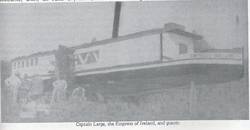Description
(1903 - ) Captain Large built his steamship the “Empress of Ireland” in his Blacksmith shop in Coulter: South Antler Steelworks.
Story: Captain Large and the Empress of Ireland
1909-1913
A Homemade Steamboat Plies the Souris River . . .
The earliest form of transportation in the West—apart from First Nation travois or walking—was by water. For centuries the Souris River served as a highway of transportation, shipping people and goods from here to there. Birch bark canoes or other man-powered boats provided all river transportation in earlier times. In the days after settlement, however, a different sort of vessel appeared.

Large
In 1908 “Captain” Hunt Johnston Rolston Large, a blacksmith from Coulter, Manitoba, got it into his head that he would build a steamship. Due to his winning personality and big Irish heart, everyone in the community had a good word to say about him, though some were sceptical that the vessel would float when the time came to test it.
Building a Steamship
Large’s workshop was not too far from the church in Coulter, and the noise from his construction caused quite the disruption of the minister’s sermons on Sunday mornings. The minister finally had a chat with Large. When one of the church elders asked the minister how the meeting had gone, he replied “It was the biggest mistake I have ever made. He knows more about the Bible than I do.” After that, however, Large refrained from working on his boat on Sunday mornings.
Large built his ship mostly out of recycled materials: a dismantled boxcar and the inside of an old house provided most of the wood he used in construction. The metal parts of the boat were made by Large himself in his little workshop, South Antler Steelworks, in Coulter (the foundations of which are still visible in Coulter today). The ship was deliberately built narrow enough so that she would fit between the posts of the CPR bridge that crossed the Souris River.
He named her the Empress of Ireland, and though she lacked a professional touch she was still a good-looking vessel.
Plying the Souris
The Empress was launched in the spring of 1909 on the Souris River right below Coulter. The townspeople gathered to watch to see if it would float or not—and it did! All season the vessel plied the Souris River between Napinka, MB and Scotia, ND. Large delighted his passengers by singing lively songs on deck, accompanying himself on the banjo. Passengers often packed a picnic lunch to enjoy on the boat, making an outing of the journey.
Moving to the Assiniboine
In the summer of 1910 the Empress left the Souris River to ply more lucrative waters: those of the Assiniboine near Brandon. She was transported by train and used as an excursion boat during the Brandon Fair. At the end of the summer she was tied down for the winter.
The Empress didn't make it until spring: an unfortunate accident caused her to burn down to the ice. All that was left was a portion of the hull, her two big boilers and the paddlewheels. Large reinvented her as a coal barge the next spring, but couldn’t bear to paint the word “Empress” on a barge, so renamed her the Assiniboine Queen. Severe floods in the spring of 1913 finally sank the craft.
One of the vessel’s steel paddlewheels, made by Large’s own hands, rests in Coulter Park at Sourisford.
. . . . .
Author: Teyana Neufeld
Source:
Brown, Roy. "Captain Large and the Empress of Ireland." Brandon: Leech Printing, 1970.
Photos: See above source.
Links:
